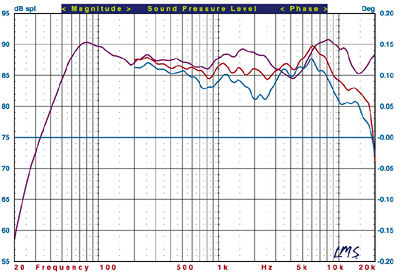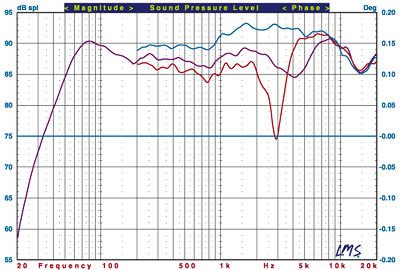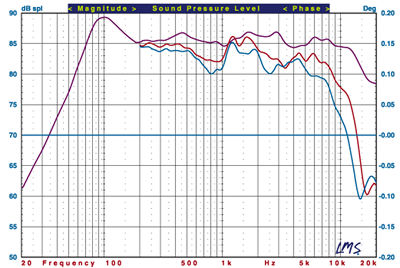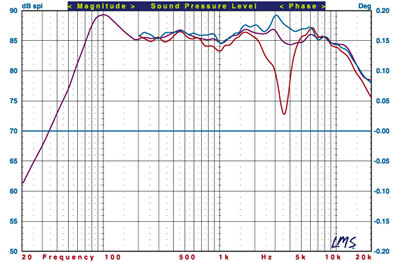Sonus Faber Grand Piano Home surround speaker system Measurements
The Grand Piano Home's ported cabinet is tuned to approximately 39Hz. Its sensitivity is about 88dB/W/m, and its impedance bottoms out at 3.8? at 39Hz and at 3.2? at 7.1kHz. We would rate the Home's nominal impedance at 5?; it should not be a difficult load for any competent amplifier.
The pseudo-anechoic response of the Grand Piano Home at tweeter height, averaged over a 30° forward horizontal angle and combined with the nearfield responses of the woofers and port, is shown in Fig.1 (violet). The useful bass extends down to approximately 37Hz (-10dB relative to the output at 1kHz). The response exhibits a smooth but prominent emphasis in the presence region at about 1.6kHz, and another in the mid-treble at about 8kHz. Together, these suggest a slightly forward sound with a trace of emphasis in the low-treble/sibilance region. (MF did note a slight sharpness in the upper mid/lower treble, but was not bothered by it.) The rise at 1.6kHz disappears as you move far off-axis, which may well reduce its audibility.

Fig.1
Fig.2 again shows the Grand Piano Home's averaged horizontal front response (violet), plus the vertical responses taken at +15° (red) and -15° (blue) relative to the tweeter. Oddly, the overall response is significantly smoother slightly below the tweeter axis. Sitting with one's ears higher than the tweeter (red curve) should be avoided.

Fig.2
The center-channel Solo Home's cabinet is tuned to about 50Hz. Its sensitivity measured approximately 86dB/W/m, with minimum impedances of 5.2? at 50Hz and 3.1? at 4.5kHz—a fair rating for the nominal impedance would be 6?. A good amplifier should have no problem driving this speaker.
The Solo Home's measured front horizontal response, taken on the tweeter axis and averaged in the same manner as described above for the Grand Piano Home, is shown in Fig.3 (violet). The useful bass extension is approximately 45Hz (-10dB). The Solo Home's response is smoother overall than the Grand Piano's, and apart from a mild suckout centered between 800Hz and1kHz, the horizontal off-axis performance is very good—and far better than that of typical center-channels, in which the tweeter is placed between two horizontally configured woofers. The Solo's ±15° vertical off-axis performance (Fig.4) is excellent, as long as the listener's ears are no higher than the tweeter axis.

Fig.3

Fig.4
Altogether, this is a good set of measurements, limited only by the slightly lumpy average frontal response of the Grand Piano Home. But set up properly—perhaps with a slightly more pronounced tilt-back to the Grand Piano than that provided by the cabinet itself—Sonus Faber's Grand Piano Home system is clearly capable of fine performance, as MF confirmed in his listening tests. —Thomas J. Norton





























































